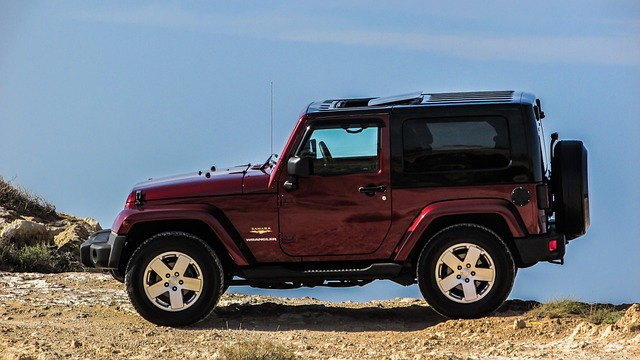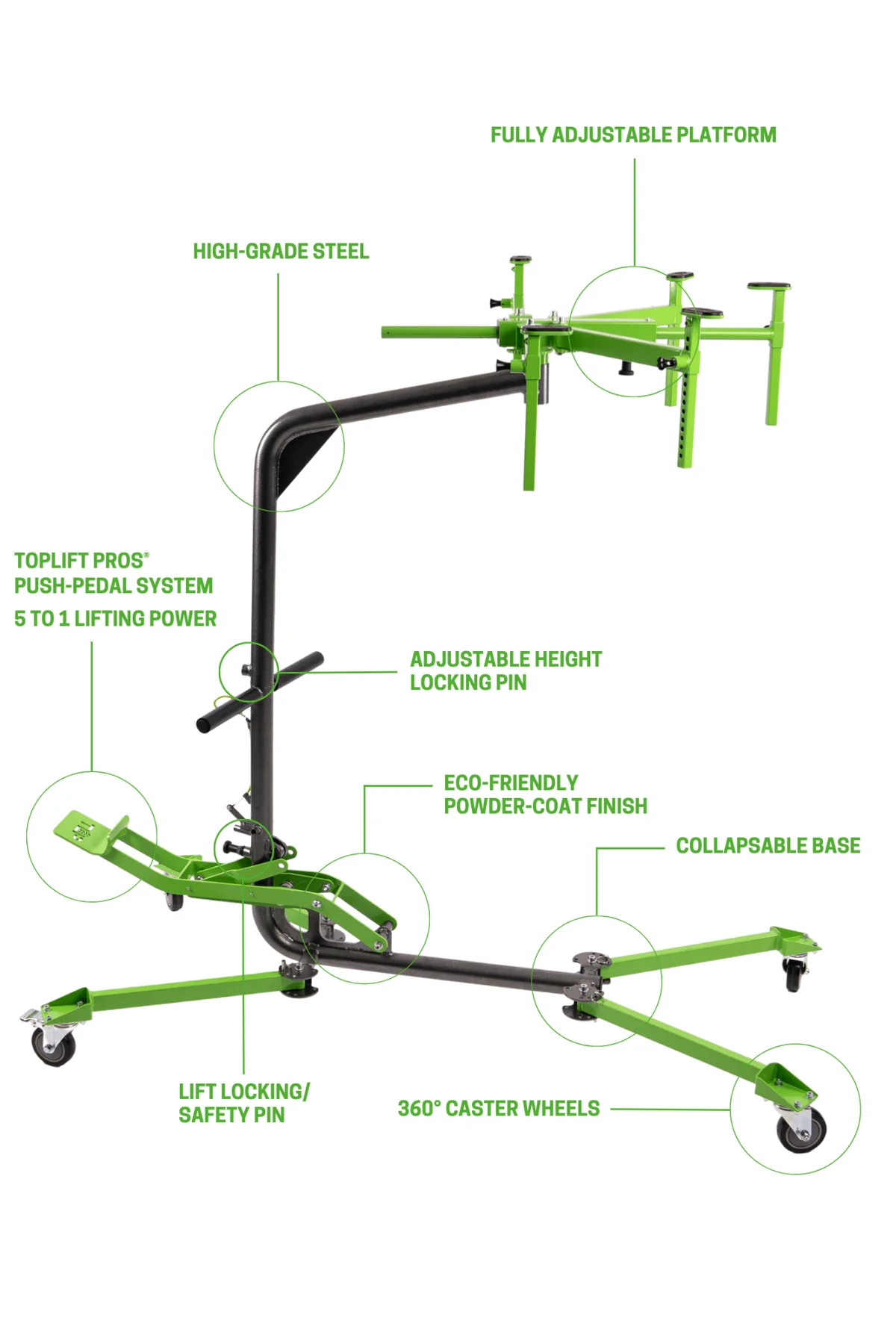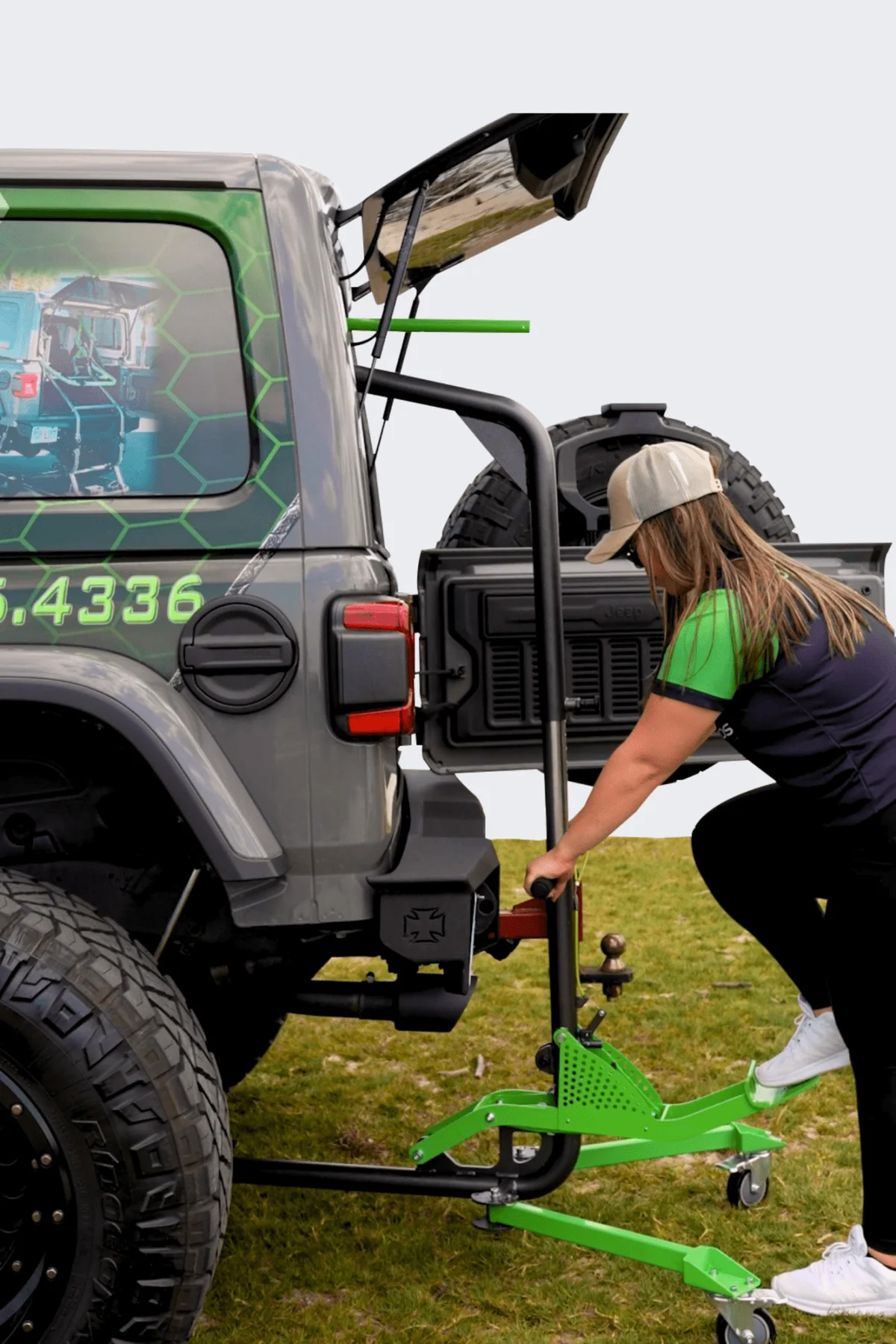The Ultimate Guide: How to Store a Jeep Hardtop Safely

Picture this: it’s summertime, and you’re ready to take off your Jeep’s hardtop to enjoy the open air and sunshine. But where do you store that bulky hardtop to keep it safe and protected? Properly learning how to store a Jeep hardtop is essential to ensure its longevity and maintain its appearance. In this ultimate guide, we’ll walk you through every step of the process, from choosing the right storage solution to maintaining your hardtop during storage.
Choosing the Right Hardtop Storage Solution
Deciding on the ideal hardtop storage solution involves considering factors like budget, space, and convenience. Your options include the user-friendly TopLift Pros Jeep Hardtop Removal Tool or going the DIY route with custom-built solutions. Either way, you need to pick a method that best suits your requirements to keep your Jeep hardtop in top condition.
The TopLift Pros Jeep Hardtop Removal Tool
The TopLift Pros Jeep Hardtop Removal Tool is a fantastic option for those who prioritize safety and efficiency. Here are some key features of this tool:
-
Patented design for one-person operation
-
Fast removal system
-
Incremental TurnNGo lift system keeps your hardtop in an upright position during the entire process
With this removal tool and storage cart, hardtop removal and storage becomes a breeze, and you don’t have to worry about slips or movements.
Designed with a compact and semi-pre-assembled form, the TopLift Pros tool is travel-friendly and easy to store. Its features include:
-
Push-Pedal System for effortless hardtop removal, eliminating the need for additional pulleys and straps
-
Smooth lifting process that saves you time and effort
-
Ideal solution for Jeep hardtop storage
DIY Solutions
If you’re looking for a more budget-friendly approach, DIY solutions can be both cost-effective and customizable. With a bit of planning and creativity, you can construct your own hardtop storage racks or cabinets using readily available materials. Some practical designs for DIY Jeep hardtop storage racks include building a storage dolly with 2x4 pieces and locking castors or setting up a hoist and door holders in your garage.
Keep in mind that manually removing a hardtop can be cumbersome and may lead to potential damage if not handled carefully. To avoid such issues, consider using tools like the TopLift Pros Jeep Hardtop Removal Tool or a harbor freight hoist when removing your hardtop.
Preparing Your Hardtop for Storage

Proper preparation of your hardtop is a prerequisite before storage. This process involves using safe removal techniques, disconnecting necessary wires, and cleaning the rear window. By following these steps, you’ll ensure that your hardtop remains in excellent condition and is ready for use when the time comes to reattach it to your Jeep.
Safe Removal Techniques
When removing your Jeep hardtop, prioritize safety above all. Using the best methods and appropriate tools can make all the difference in following proper lifting techniques.
Portable carts or overhead hoists are recommended for hardtop removal, as they provide stability and support during the process. If needed, seek assistance from someone to help you lift the hardtop up and clear it of supports.
Disconnecting Defroster Wires and Other Connections
Disconnecting the defroster wires and other connections is a necessary step before storing your hardtop. Failing to do so can result in damage to the wires and connectors, potentially impacting the defroster’s performance or rendering it inoperable.
To disconnect the defroster wires and other connections, locate the wiring harness and follow the specific instructions provided by the manufacturer or consult a Jeep owner’s forum for detailed guidance.
Cleaning the Rear Window
To maintain visibility and prevent dirt buildup, ensure you clean the rear window of your Jeep hardtop before storage. Using a straight edge razor blade and a lubricating cleaner or oil, remove any oxidation stains from the rear window. Then, clean the entire surface of the rear window with a mild dishwashing detergent to remove dirt and grime.
By taking these steps, you’ll ensure that your hardtop is ready for storage and in top-notch condition for future use.
Proper Hardtop Storage Practices
With your hardtop safely removed and prepared for storage, you can now concentrate on the right storage practices. These include selecting the right location, positioning the hardtop correctly, and protecting it from potential damage. By following these practices, you’ll ensure that your hardtop remains in excellent condition throughout the storage period.
Selecting the Right Location
Selecting an appropriate location for hardtop storage is of utmost importance. Factors to consider include weather protection, accessibility, and available space. The ideal storage location should be sheltered, secure, and clean to prevent damage from weather conditions and potential contaminants.
Keep in mind the recommended temperature (65-70°F) and humidity levels (40%-50%) for storing a hardtop, as these factors can impact its condition quite a bit.
Positioning the Hardtop
For damage prevention and structural integrity maintenance, it’s vital to position your hardtop correctly during storage. The most suitable positioning for storing a Jeep hardtop is upright, either leaning against a wall or on a storage rack/cart, putting extra care into its placement.
Avoid placing your hardtop directly on the ground, as this can lead to damage from moisture or uneven surfaces.
Protecting Your Hardtop
To avoid scratches and dirt accumulation, it’s important to protect your hardtop during storage. Using covers or tarps made of suitable materials, such as custom-fit hardtop covers, waterproof and breathable fabric, or durable polycotton blend, can help protect your hard tops from potential harm.
By taking these precautions, you’ll ensure that your hardtop stays in pristine condition and ready for reinstallation when needed.
Maintaining Your Hardtop During Storage
Regular maintenance of your stored hardtop is necessary for its long-term use and functionality upon reinstallation. This involves inspecting your hardtop for any signs of wear and tear, cleaning and polishing its surface, and checking hardware and connections.
Regularly Inspecting the Hardtop
Periodic inspections of your stored hardtop can help in early identification and resolution of potential issues. It’s advisable to inspect your hardtop at least once every few months to evaluate it for cracks, damage, and indications of wear and tear. By doing so, you can ensure that your hardtop remains in excellent condition and is ready for use when the time comes to reattach it to your Jeep.
Cleaning and Polishing
To maintain your hardtop’s appearance during storage, follow these steps:
-
Clean the surface of the hardtop using recommended cleaning products such as Turtle Wax Ice, 303 spray, or Pledge furniture polish.
-
Polish the hardtop to restore its luster and shine.
-
Regularly clean the hardtop to remove dirt and debris, ensuring that it maintains its appearance.
By taking proper care of your hardtop, you’ll ensure that it remains in top-notch condition for future use, just like a well-maintained soft top.
Checking Hardware and Connections
Throughout storage, ensure the security and functionality of your hardtop by regularly checking hardware and connections. Conduct regular inspections of the hardware and connections, preferably every 3-6 months, to guarantee everything is safe and functioning properly. By doing so, you can address any potential issues promptly and ensure that your hardtop is ready for use when needed.
Frequently Asked Questions
How do I protect my Jeep hardtop?
For optimal protection of your Jeep hardtop, applying a Trim Protectant with the help of a foam brush or roller and taping off the top with painter's tape is recommended. This will ensure up to six months of protection.
How long does a Jeep hardtop last?
Hardtops are far more durable and able to last the entire lifespan of your Jeep, compared to a soft top which typically lasts between three to five years.
What are the benefits of using a TopLift Pros Jeep Hardtop Removal Tool?
The TopLift Pros Jeep Hardtop Removal Tool provides a quick, convenient and secure way to remove and store your Jeep hardtop with its user-friendly design and patented lifting system. It allows you to remove your top in two minutes or less, without having to crawl around on the ground or hassle with complicated straps.
The tool also eliminates the need for an extra person to help lift and carry your hardtop, making it a great option for anyone looking for a safe and easy way to remove their hardtop. It is also designed for use both indoors and outdoors, giving you the freedom to store your top in any environment.
In addition to providing convenience, the TopLift Pros Jeep Hardtop Removal Tool also offers a variety of other benefits. It is made from high-quality durable materials that are designed to last and resist corrosion, ensuring your hardtop remains secure even after repeated use.
How can I create a DIY hardtop storage solution?
Build your own hardtop storage solution using materials such as 2x4 pieces and locking castors to construct a storage dolly or set up a hoist and door holders in your garage.
What is the importance of disconnecting defroster wires and other connections before storing my hardtop?
Disconnecting defroster wires and other connections before storing your hardtop is essential to maintain its performance and protect electrical components from damage.





